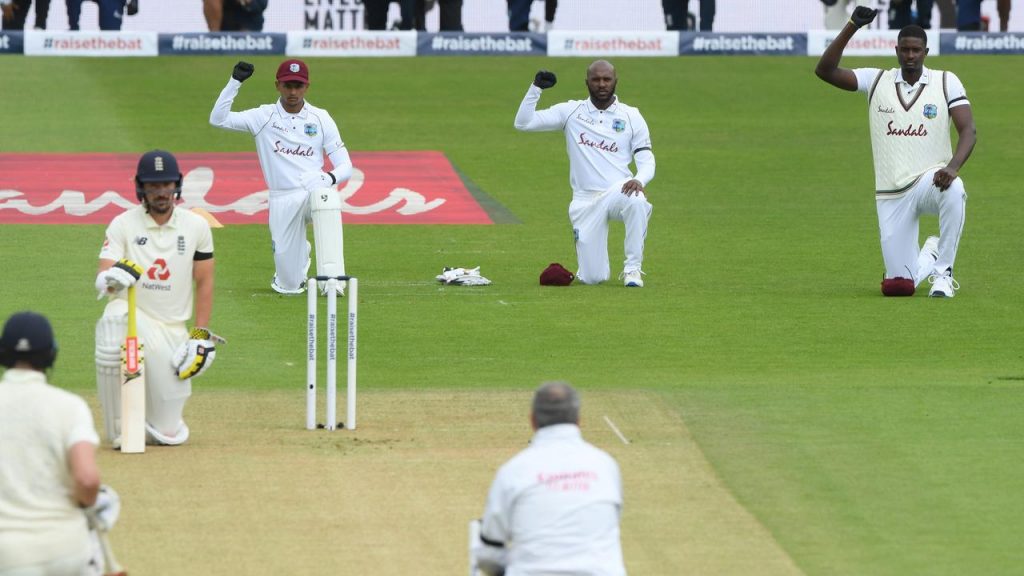Under regular circumstances, the first morning of a Test match—the most celebrated structure of cricket, contested between worldwide teams, sporting standard white uniforms, for a most of five days—feels like a holiday. The game always starts on a weekday, and many spectators take time off work to watch it. On the opening morning of a Test in Manchester, the streets near the stadium at Old Trafford are thronged with cricket fanatics carrying luggage crammed with sandwiches, newspapers, binoculars, and rain jackets. Groups of followers put on costumes: a dozen Fred Flintstones; a gang of pink letterboxes; a Tour de France peloton. Scalpers ask, sotto voce, to buy or sell. The noise of expectant chatter rises as the crowds thicken. The bars around the stadium do brisk business.
A current three-match Test collection between England and the West Indies was once not performed below ordinary circumstances. On the first morning of the determining Test of an intriguing collection tied at 1–1, I walked twenty-five minutes from my residence along near-empty streets to the entrance gate at Old Trafford, alone. The cause for my solitude was once covid-19, naturally. In March, when the novel coronavirus commenced upending lifestyles and ending lives, it additionally regarded to have destroyed the danger of expert or recreational cricket being performed in England in the spring and summer time of 2020. Scratching a cricket season was a minor consideration in the context of a world pandemic, however it was a cause of actual unhappiness to fans and gamers of the game.

Neville Cardus, the Mancunian grandfather of cricket writing, wrote, “There can be no summer time in England without cricket.” In the early days of the pandemic, the England and Wales Cricket Board, like different carrying bodies, seemed for a way to salvage something—not least television revenue—from the spoiled calendar. In early May, the E.C.B. proposed an idea: biosecure cricket. The idea was once comparable to the “bubbles” presently in use by the N.B.A. and professional soccer leagues, however cricket’s bubble would be elaborate by means of the duration of a series, and by means of the need for global travel. A group would arrive from overseas, meet no one but themselves, remain in hotels that adjoined cricket stadiums, and be subjected to everyday clinical tests. The England crew would be in a similar fashion confined. On the field, gamers may want to no longer polish the ball the usage of saliva, in their customary way; they were obligated to use solely their own sweat. (In June, when Prime Minister Boris Johnson was once requested why nonprofessional cricket remained banned, he said that a cricket ball was a “natural vector of disease.” Recreational cricket resumed in July, with much less spit than usual, and greater sanitizer.) Around a hundred and twenty tv and radio broadcasters would follow the series, however the majority would not return domestic between games. Selected print journalists would gain get right of entry to to matches in tiny groups, but would not mingle with every person else. There would be no paying spectators.
The West Indies team—made up of gamers from English-speaking Caribbean nations—agreed to play England in a three-match series: one in Southampton and two in Manchester. Pakistan and Australia arranged to play England below comparable stipulations later in the season. (The first Test against Pakistan started this week.) International cricket played in England barring crowds used to be a sterile prospect, in extra than one sense, but it was once nevertheless cricket. A summer time was possible.
Cricket is a mystery to most Americans. I won’t explain all of its finicky laws, but the necessities are convenient sufficient to understand. Two teams take turns to bat. The batters try to score runs; the bowlers try to get them “out.” You are out if the ball hits your stumps, or a fielder catches a ball you have hit, or in exactly eight different ways. A team is “all out” when ten batsmen have been dismissed. In newer formats of the game, which restrict a suit by way of the number of balls every aspect can face, whichever team rankings the most runs wins. In extra typical forms, which are confined via time, there can be a draw (but no longer a tie, which skill some thing different in cricket) if the crew batting remaining is now not all out. The specific versions of the sport are mirrored in their aesthetics. In short forms, players wear garish uniforms and use a white ball. In ordinary cricket, they play in white and use a pink ball.

